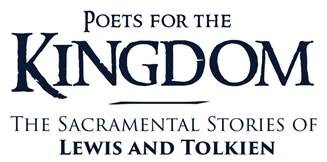TOB 546 Elective: Poets for the Kingdom: The Sacramental Stories of Lewis & Tolkien (2 credits)
Class
About

Syllabus
ELECTIVE Course
Instructor:
Bill Donaghy
Course Hours: 30 classroom hours
Course Description: Perhaps no two authors in the last century have touched so many millions of lives with their deeply Christian imaginations than C.S. Lewis and J.R.R. Tolkien. Their desire to create "new mythologies" for England has quite literally touched the whole world, baptizing and evangelizing the imagination with a prophetic vision that speaks powerfully and critically to our reductionistic and "demythologized age". This course, combined with the sacramental vision of St. John Paul II in the Theology of the Body and his Letter to Artists, will delve deeply into the fellowship of these two great men, revealing how their personal histories and shared experiences shaped the writings that continue to shape new generations of readers. We will also explore their sacramental imagination through a host of their novels, stories, poems and letters. As St. John Paul II wrote, "Humanity in every age, and even today, looks to works of art to shed light upon its path and its destiny." (Letter to Artists)
Required Reading:
· C.S. Lewis, Ransom Trilogy (also known as the Space Trilogy):
- C.S. Lewis, Out of the Silent Planet
- C.S. Lewis, Perelandra
- C.S. Lewis, That Hideous Strength
· C.S. Lewis, The Weight of Glory, essay
· C.S. Lewis, The Great Divorce
· J.R.R. Tolkien, The Lord of the Rings Trilogy:
- J.R.R. Tolkien, The Fellowship of the Ring
- J.R.R. Tolkien, The Two Towers
- J.R.R. Tolkien, The Return of the King
· J.R.R. Tolkien, On Fairy Stories, essay
· J.R.R. Tolkien, Leaf by Niggle
Supplemental Reading:
· C.S. Lewis, Mere Christianity
· C.S. Lewis, Screwtape Letters
· C.S. Lewis, Till We Have Faces
· C.S. Lewis, Chronicles of Narnia
· J.R.R. Tolkien, The Hobbit
· J.R.R. Tolkien, The Silmarillion
· J.R.R. Tolkien, Letters of Tolkien
Learning Objectives: The course is designed
• to introduce the student to the wisdom and some of the works of C.S. Lewis and J.R.R. Tolkien, both fictional and academic.
• to familiarize the student with the personal life stories and experiences of these men and how it shaped their vision and mission as scholastics, authors, and Christians.
• to inform the student of the cultural and philosophical issues addressed by these authors in their own time and the prophetic relevance of these same issues in contemporary society.
• to equip students with a creative imagination and the apologetic of Beauty employed by Lewis and Tolkien as a means for personal conversion and a tool for cultural conversation and evangelization.




